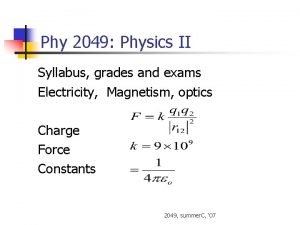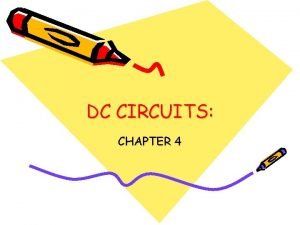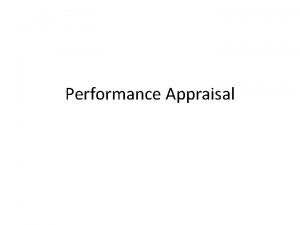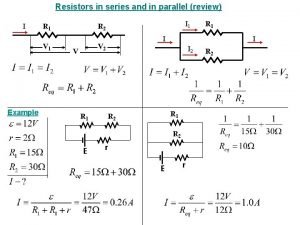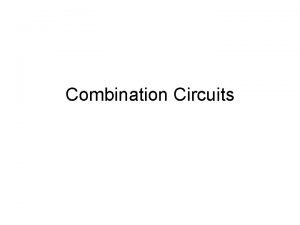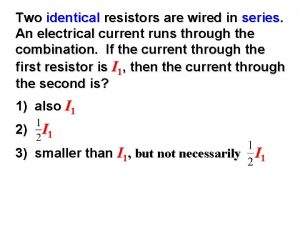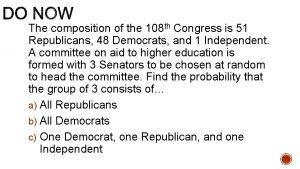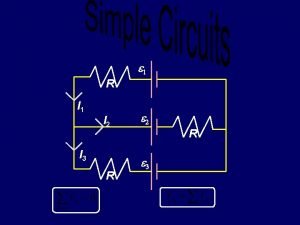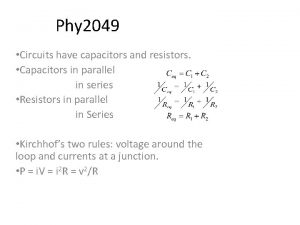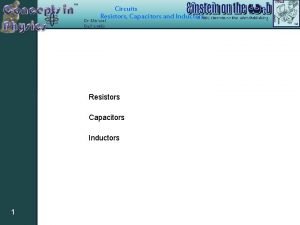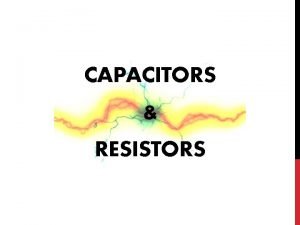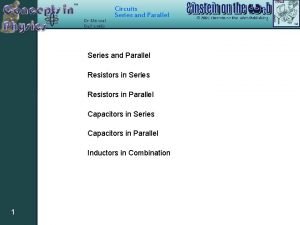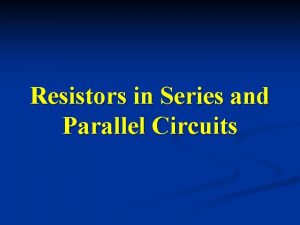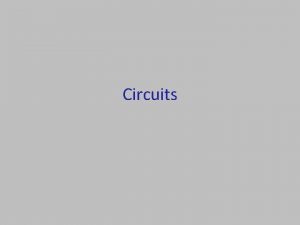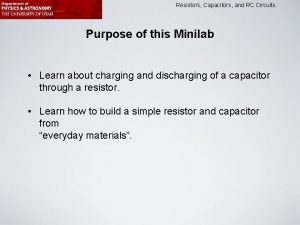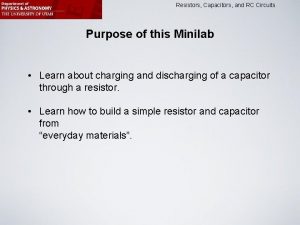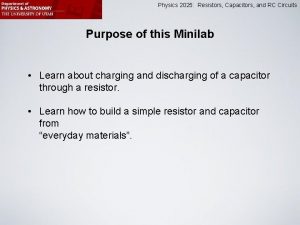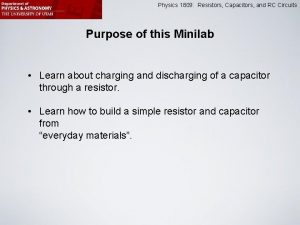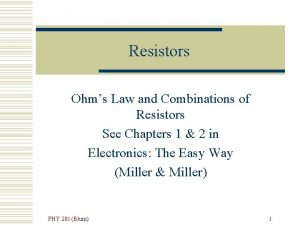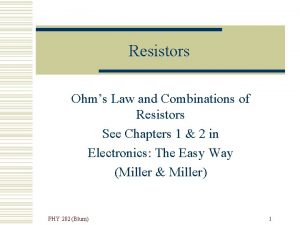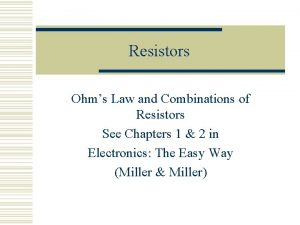Phy 2049 Circuits have capacitors and resistors Capacitors















- Slides: 15

Phy 2049 • Circuits have capacitors and resistors. • Capacitors in parallel in series • Resistors in parallel in Series • Kirchhof’s two rules: voltage around the loop and currents at a junction. • P = i. V = i 2 R = v 2/R

In the diagram R 1 > R 2 > R 3. Rank the three resistors according to the current in them, least to greatest. A. 1, 2, 3 B. 3, 2, 1 C. 1, 3, 2 D. 3, 1, 3 E. All are the same

I. In the diagram, the current in the 3 -resistor is 4 A. The potential difference between points 1 and 2 is: A. 0. 75 V B. 0. 8 V C. 1. 25 V D. 12 V E. 20 V

A. 5 Ω B. 7 Ω C. 2 Ω D. 11 Ω E. NOT


(27 – 11)

R i motion - + motion (27 – 6)

R 1 = 1 and R 2 = 2 Ὠ E 1 = 2, E 2 = E 3 = 4 V Size and direction of current in E 1 and E 2 Va-Vb Kirchhof’s rules: Choose current (magnitude and direction) in all branches. At junction a (or b), I 1 = I 2+I 3. (a) We note that the R 1 resistors occur in series pairs, contributing net resistance 2 R 1 in each branch where they appear. Since e 2 = e 3 and R 2 = 2 R 1, from symmetry we know that the currents through e 2 and e 3 are the same: i 2 = i 3 = i. Therefore, the current through e 1 is i 1 = 2 i. Then from Vb – Va = e 2 – i. R 2 = e 1 + (2 R 1)(2 i) we get Consider the right box loop, go clockwise. I 3(2 R 1)-E 3+E 2 -I 2 R 2 = 0 I 3 = I 2 for the numbers above. And I 1 = 2 I 2 Now the left loop, clockwise: Therefore, the current through e 1 is i 1 = 2 i = 0. 67 A. (b) The direction of i 1 is downward. (c) The current through e 2 is i 2 = 0. 33 A. (d) The direction of i 2 is upward. (e) From part (a), we have i 3 = i 2 = 0. 33 A. (f) The direction of i 3 is also upward. (g) Va – Vb = –i. R 2 + e 2 = –(0. 333 A)(2. 0 W) + 4. 0 V = 3. 3 V. 2 + 2 I 1 +2 I 2 - 4 = 0 I 2 = 0. 33 A = I 3 I 1 = 0. 67 A The current directions are correct as chosen at the outset.

R = 4 Ω, V = 4 V, what is the current through R?

R = 4 Ω, V = 4 V, what is the current through R? 4+4+4 -4 -4 I=0 I = 2 A

Obtain current in all branches of this circuit by repeated application of Kirchhof’s loop and junction rules

• What is i? All V = 10 Volts and all R = 4 Ohms

j k • What is i? All V = 10 Volts and all R = 4 Ohms? • What is j? What is k?

j k • What is i? All V = 10 Volts and all R = 4 Ohms -10 +10+10 -10 -10 -10 +10 I = 0 I = 4 A

• Three circuits are connected to a battery. Rank them by the – final charge – Time constant
 Phy 2049
Phy 2049 Phy 2049
Phy 2049 Capacitor in dc circuit
Capacitor in dc circuit Selection validation in performance appraisal
Selection validation in performance appraisal Advantages of parallel circuits over series circuits
Advantages of parallel circuits over series circuits Resistors in series and parallel
Resistors in series and parallel Resistors in series and parallel equations
Resistors in series and parallel equations Simplifying resistors
Simplifying resistors Identical resistors
Identical resistors A package contains 12 resistors 3 of which are defective
A package contains 12 resistors 3 of which are defective Intrinsic semiconductor
Intrinsic semiconductor Kmart breadboard
Kmart breadboard Two cylindrical resistors are made from the same material
Two cylindrical resistors are made from the same material Phy113
Phy113 Phy 131 past papers
Phy 131 past papers Pa msu
Pa msu

